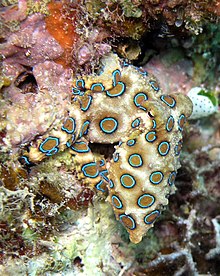Greater blue-ringed octopus
| Greater blue-ringed octopus | |
|---|---|
 |
|
| Hapalochlaena lunulata | |
| Scientific classification | |
| Kingdom: | Animalia |
| Phylum: | Mollusca |
| Class: | Cephalopoda |
| Order: | Octopoda |
| Family: | Octopodidae |
| Subfamily: | Octopodinae |
| Genus: | Hapalochlaena |
| Species: | H. lunulata |
| Binomial name | |
|
Hapalochlaena lunulata (Quoy & Gaimard, 1832) |
|
The greater blue-ringed octopus (Hapalochlaena lunulata) is one of four species of venomous blue-ringed octopuses belonging to the octopodidae family.
The greater blue-ringed octopus is, despite its vernacular name, a small octopus whose size does not exceed 10 centimeters, arms included, for an average weight of 80 grams. Its common name comes from the relatively large size of its blue ring (7 to 8 millimeters in diameter), so they are indeed larger than those of the other members of the genus and help to distinguish them. The head is slightly flattened dorsoventrally and finished in a tip. Its height arms are short.
The coloration of this octopus varies with the circumstances and the ambient environment from yellow ocher to light brown through whitish (when inactive). The blue rings are about 60, spread throughout the entire animal's coat. The rings are roughly circular and are based on a darker blotch than the background color of the coat. A black line, whose thickness can vary to increase the contrast and be more visible, borders the electric blue circles. The blue rings are an aposematic adornment whose purpose is to clearly show to all potential predators that this octopus is highly poisonous. They also have characteristic blue lines running through their eyes.
The greater blue-ringed octopus is widespread throughout the tropical and subtropical waters of the Indo-West Pacific from Sri Lanka to the Philippines and from Australia to south Japan.
The greater blue-ringed octopus likes shallow waters with mixed seabed (rubble, reefs, sandy areas ...). Like all octopuses, it lives in a burrow and only comes out to search for food or a mate. The entrance of the shelter is littered with legs from meals (empty shells and crab shell and legs) and it's quite easily identifiable.
The greater blue-ringed octopus is a benthic animal which has a solitary way of life. The breeding season varies according to geographical area, the female lays 60 to 100 eggs which are kept under the female's arms during the incubation period, which lasts about a month. Newborns have a brief planktonic development passage before settling on the seabed.
...
Wikipedia
